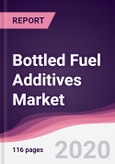What is Bottled Fuel Additives?
Fuel additives are kind of chemicals which are added to fuels which cleans and lubricates the fuel engine to enhance its performance and it also reduces emissions. Fuel additives which are produced in bottles volume ranging from ounce to gallon can be termed as bottle fuel additives. Not all but only few fuel additives can only be supplied in bottles such as demulsifiers, cetane improvers, corrosion inhibitors, metal deactivators, detergents and anti-knocking additives.
Growing awareness towards the reduction of carbon footprint and toxic emissions has led to show upward trend for the growth of lubricant additives that are free from metals and other pollutant compounds. Extensive use of metals, non-ferrous alloys and their over soon deterioration in lubricating systems is yet another reason for the expansion of market size of bottled fuel additives industry.
What are the major applications of Bottled Fuel Additives?
The various end users assessed includes Diesel, Gasoline, Biofuel, Industrial, Marine Fuel and Aviation Fuel. Diesel and Gasoline are the dominant end users in generating global market share. Additives help mainly in enhancing safety, cost saving, revenue enhancing and performance enhancement. This is due to including octane improvers, corrosion inhibitors, metal deactivators and anti-oxidants.
Bottle fuel additives are added to Gasoline, biofuel and others, which helps in reducing the combustion level in fuel engines and enhance the performance of the engine.
Bottled Fuel Additives Market
Market Research and Market Trends of Bottled Fuel Additives:
Polartech EA 700 - A Unique Low Foam Emulsifier Additive for Metalworking: Ultra speed metal working devices are stronger than ever before, but with this fluid delivery pressures and temperature increases foam and stress on emulsions. To address the challenge of high pressure coolant delivery systems, Afton has introduced Polartech EA 700, an innovatively designed polymer specifically for metal working applications. The product is rigorously researched and continuously tested to deliver the best-in-class low foam performance in severe machining conditions.
BG Full Synthetic Electric Power Steering Fluid: Systems which perform at high temperatures usually carries the risk of fluid deterioration. In addition, this deterioration causes friction, accelerates system wear, and builds up the accumulation of deposits. The full synthetic electric power steering fluid is the optimal solution to address the above mentioned challenges.
BG Brake Fluid Conditioner: This boosts anti-corrosion properties, maximizes brake fluid performance and ensures safe stopping. It has been known to deteriorate before manufacturer recommended brake service intervals. Thus vehicle’s stopping ability is determined by the effectiveness of rusted brake parts. Brake Fluid conditioner will reduce the deterioration in the vehicle brakes.
Who are the Major Players in the market?
The key players in the Bottled fuel additives market are Afton Chemical Corporation, Chevron Oronite Company LLC., Total S.A., BASF SE, Lucas Oil Products, Inc., Ashland Inc., BG Products, Inc., Lubrizol Corporation, Infineum International Ltd and more than 20 companies.
What is our report scope?
The report incorporates in-depth assessment of the competitive landscape, product market sizing, product benchmarking, market trends, product developments, financial analysis, strategic analysis and so on to gauge the impact forces and potential opportunities of the market. Apart from this the report also includes a study of major developments in the market such as product launches, agreements, acquisitions, collaborations, mergers and so on to comprehend the prevailing market dynamics at present and its impact during the forecast period 2017-2025.
Key Takeaways from this Report
Evaluate market potential through analyzing growth rates (CAGR %), Volume (Units) and Value ($M) data given at country level – for product types, end use applications and by different industry verticals.
Understand the different dynamics influencing the market – key driving factors, challenges and hidden opportunities.
Get in-depth insights on your competitor performance – market shares, strategies, financial benchmarking, product benchmarking, SWOT and more.
Analyze the sales and distribution channels across key geographies to improve top-line revenues.
Understand the industry supply chain with a deep-dive on the value augmentation at each step, in order to optimize value and bring efficiencies in your processes.
Get a quick outlook on the market entropy – M&A’s, deals, partnerships, product launches of all key players for the past 4 years.
Evaluate the supply-demand gaps, import-export statistics and regulatory landscape for more than top 20 countries globally for the market.
Table of Contents
Methodology

LOADING...








